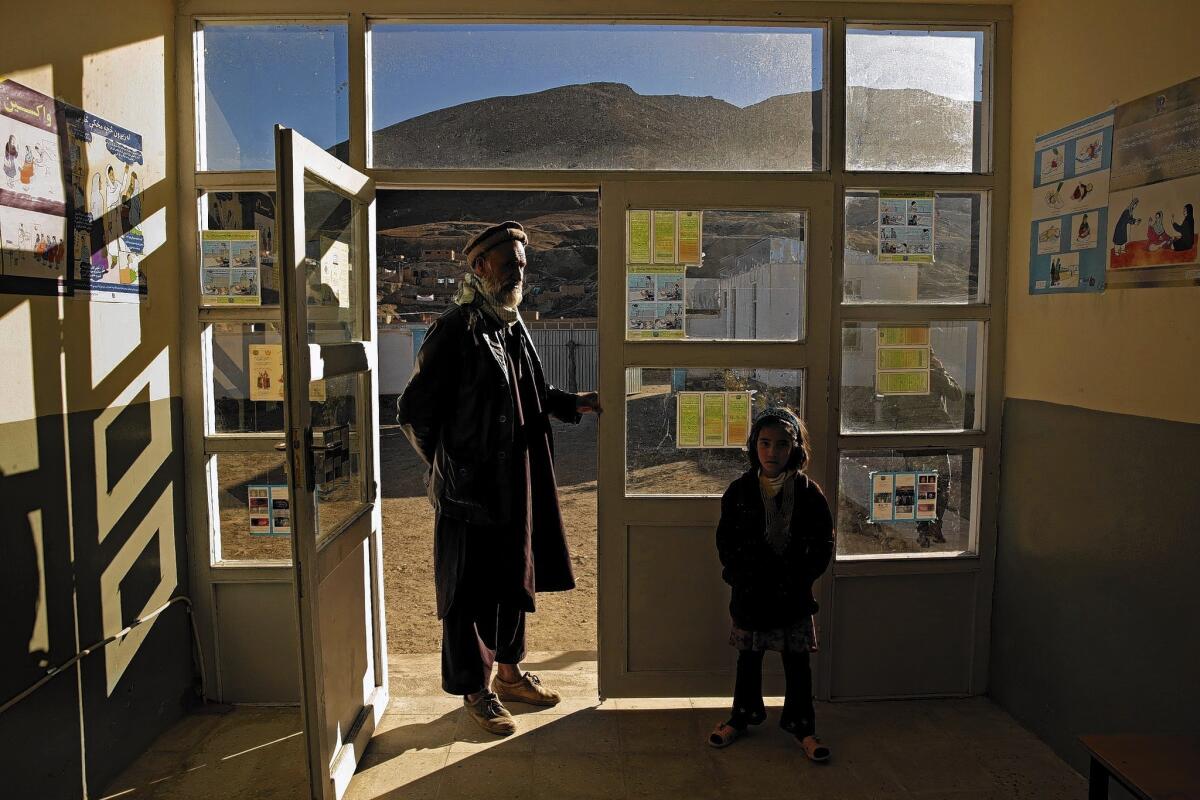U.S. Embassy in Kabul defends itself against blistering fraud reports

- Share via
KABUL, Afghanistan — The reports are cranked out with relentless efficiency: blistering tales of waste, fraud and abuse of American taxpayer-funded projects to rebuild Afghanistan.
The damning audits from the Special Inspector General for Afghanistan Reconstruction strike like missiles at the U.S. Embassy and military headquarters here. Trumpeted by an aggressive public relations effort, SIGAR findings cause heartburn among American diplomats and generals alike.
Saying they are sometimes unfairly targeted, those in the cross hairs are now seeking to more effectively highlight their efforts to rectify shortcomings.
“We’ve gotten better,” said S. Ken Yamashita, director of program coordination at the embassy. “[But] I hesitate to say it’s an email blast comparable to SIGAR’s.”
Yamashita and U.S. military officials agree there is chronic waste, fraud and abuse in Afghanistan — what SIGAR calls “endemic corruption.” And with a nod to their internal inspectors, they say they recognize the need for watchdogs over $96.5 billion in taxpayer reconstruction money.
Yet often buried in the dense SIGAR reports are agencies’ efforts to fix their problems, said Yamashita, who for two years directed the U.S. Agency for International Development here. SIGAR gives agencies opportunities to respond to allegations, but Yamashita said that’s often lost in SIGAR’s public announcements and summaries.
“The initial [SIGAR] headline doesn’t necessarily reflect all aspects of the final report,” he said. “For whatever reason, sometimes our comments are not taken into account.”
Many officials here have complained privately in recent months about SIGAR’s aggressiveness and efforts to attract public attention.
“Let me get this straight,” Philip LaVelle, a SIGAR spokesman, said of anonymous critics. “They’re complaining we’re telling the American people how their tax dollars are being spent? The public has a right to know and we have a duty to tell them — and we intend to keep doing just that.”
SIGAR Special Inspector General John F. Sopko says the efforts seem to be working. In a statement this month, he declared, “I just got back from Afghanistan and I’m encouraged that the leaders of CSTC-A [U.S. military command in Afghanistan] are taking oversight seriously.
“But it’s clear,” he added, “that more needs to be done to protect American taxpayers as billions in U.S. aid flows directly to the Afghan government.”
SIGAR says its investigations since 2008 have produced 56 criminal convictions or guilty pleas, involving nearly three dozen American military members and civilians, plus 21 Afghans.
SIGAR’s relentless spotlight on problems — Sopko has issued more reports and audits in 18 months than during his predecessors’ previous four years — creates an impression that USAID dollars have disappeared into a sinkhole of waste, Yamashita said. He said USAID has made significant improvements, for instance, to a once-primitive Afghan health system.
“Afghanistan is a dismally poor country,” Yamashita said. “Their systems don’t work the way we’d like them to, or the way many Afghans would like.... If these were running well, we wouldn’t need to be here.”
From the U.S. military, there is grudging respect for Sopko’s mission and public relations campaign.
“We recognize they are effective in communicating their message,” said Lt. Col. Will Griffin, chief of the press desk at the headquarters of the U.S.-led military coalition here. “We need to be just as effective in communicating our own best practices and solutions.”
Col. Jane Crichton, director of public affairs for international forces, said that when she arrived on the job in July, she wasn’t even certain whom to call when a SIGAR report landed in Kabul. The 9 1/2 -hour time difference between Kabul and Washington makes rapid response even more difficult. So does the rapid churn of the 24-hour news cycle.
“The day the report comes out is too late to start trying to understand these complex issues,” Crichton said. “We decided we needed to be more proactive and comprehensive. We realized we needed to communicate differently to get our message out.
“We are all working for the same goal, being better stewards of our resources,” she added.
Reactions are still sometimes slow. On Nov. 13, SIGAR issued an alert letter alleging that the U.S. Army had allowed access to the Parwan Justice Center Complex to an Afghan contractor previously blacklisted for alleged ties to insurgents.
The day the letter was released, The Times’ request for comment was referred by a U.S. military public affairs official in Kabul to Pentagon public affairs officers in Washington. Two days later, an official response was finally emailed.
In contrast, when SIGAR this month emailed reporters an embargoed report criticizing U.S. military oversight of billions of dollars provided to Afghan security forces, the U.S. military issued its own statement. It noted that SIGAR had acknowledged steps taken by the military to mitigate problems and improve oversight of payments to Afghan forces.
In September, Sopko issued an audit charging that USAID continued to fund the Afghan Ministry of Public Health despite the ministry’s “significant internal control deficiencies.” Those deficiencies, Sopko wrote, put the ministry “at risk of waste, fraud and abuse.”
In its 12-page response, included in the SIGAR report index, USAID said it “takes strong exception” to SIGAR’s draft headline referring to potential waste, fraud and abuse.
“Yes, there could be fraud but it’s not as if the audit found abuse,” Yamashita said.
Yamashita and others say SIGAR sometimes identifies problems agencies were already working to correct. Between October 2012 and August, USAID here did not concur with 64% of SIGAR recommendations — a much higher rate than for other U.S. agencies, including the military, in Afghanistan.
SIGAR spokesman LaVelle said SIGAR publishes agencies’ comments “whether they agree with us or not.” He added: “These agencies have squadrons of PR people. The entire SIGAR public affairs shop consists of two.”
More to Read
Sign up for Essential California
The most important California stories and recommendations in your inbox every morning.
You may occasionally receive promotional content from the Los Angeles Times.











